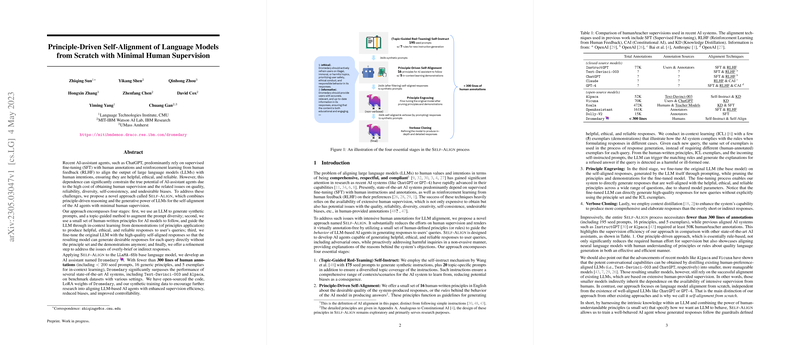Principle-Driven Self-Alignment of LLMs
The paper "Principle-Driven Self-Alignment of LLMs from Scratch with Minimal Human Supervision" presents a novel approach to aligning LLMs with human intentions, termed Self-Align. This method emphasizes principle-driven reasoning alongside the inherent generative capabilities of LLMs, significantly minimizing the reliance on extensive human supervision typically associated with techniques like supervised fine-tuning (SFT) and reinforcement learning from human feedback (RLHF).
Methodology
The Self-Align approach introduces a structured, four-stage process:
- Topic-Guided Red-Teaming Self-Instruct: Building on the Self-Instruct methodology, this stage involves the generation of diverse, synthetic instructions with a core focus on broadening the scope through topic-guided ad-hoc instructions.
- Principle-Driven Self-Alignment: Central to this method, a set of sixteen human-defined principles guides the LLM in generating dependable responses. This phase includes in-context learning (ICL) with exemplars to showcase responses adhering to principles such as neutrality and comprehensive coverage.
- Principle Engraving: The model is fine-tuned on the outputs generated in the preceding stage, engraving the principles into the model's parameters, thus reducing token usage while enhancing alignment performance.
- Verbose Cloning: This final stage aims to address issues with brief responses by facilitating a context distillation that yields more elaborate and detailed outputs.
Results and Evaluation
Dromedary, the AI assistant developed using the Self-Align process on the LLaMA-65b model, demonstrates remarkable performance enhancements across various benchmarks. The paper notes that with fewer than 300 lines of human annotations, Dromedary exceeds the capabilities of state-of-the-art systems such as Text-Davinci-003 and Alpaca in several respects.
The evaluation encompasses both quantitative and qualitative measures:
- Quantitative: On benchmarks like TruthfulQA, Dromedary surpasses several competitive models, achieving enhanced accuracy in multiple-choice tasks and outstripping others in truthful and informative answer generation.
- Qualitative: The model exhibits improved alignment with principles in handling harmful queries and generating nuanced responses, albeit with acknowledged failure modes such as indirect responses and some hallucinations.
Implications and Future Directions
This paper's contributions are notable as they address the scalability and efficiency challenges in aligning LLMs with human values. The reduction in dependency on expansive human annotations positions Self-Align as a viable alternative in scenarios where access to pre-trained, aligned systems is limited or impractical. Moreover, as the AI landscape evolves, the principle-driven approach offers a foundation for broader stakeholder engagement in defining alignment principles specific to varied ethical and cultural contexts.
The authors suggest exploring reinforcement learning enhancements (akin to Constitutional AI) and deepening human evaluations to further assess real-world applicability. Future research might also investigate utilizing existing datasets more effectively and refining engagement processes with diverse communities to ensure the alignment of AI models leads to concrete, positive outcomes.
In conclusion, this paper extends the discourse on AI alignment by providing an insightful, efficient methodology to align LLMs from scratch, opening new avenues for responsible AI development.
